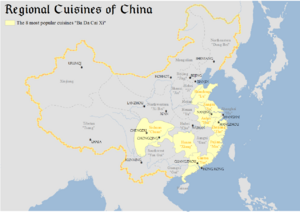Jiangsu cuisine facts for kids
Quick facts for kids Jiangsu cuisine |
|||||||
|---|---|---|---|---|---|---|---|
| Traditional Chinese | 江蘇菜 | ||||||
| Simplified Chinese | 江苏菜 | ||||||
|
|||||||
| Su cuisine | |||||||
| Traditional Chinese | 蘇菜 | ||||||
| Simplified Chinese | 苏菜 | ||||||
|
|||||||
Jiangsu cuisine (simplified Chinese: 苏菜; traditional Chinese: 蘇菜; pinyin: Sū cài), also known as Su cuisine, is one of the Eight Great Culinary Traditions of Chinese cuisine. It comes from the cooking styles of Jiangsu Province in eastern China. Jiangsu cuisine is known for its soft texture, but the food still holds its shape. It also focuses on the perfect cooking temperature. For example, meat is very tender but stays on the bone when you pick it up.
Since Jiangsu Province is close to the sea and many rivers, fish is a very common ingredient. Chefs choose ingredients carefully based on the season. They also pay attention to how the dishes look, making sure the colors and shapes are appealing. Using soup to add flavor is another key part of this cuisine. The city of Shanghai used to be part of Jiangsu, so its food is quite similar. Sometimes, Shanghai cuisine is even considered a part of Jiangsu cuisine.
Exploring Jiangsu Cuisine: Main Styles
Jiangsu cuisine is often called Su cuisine. One of its most famous styles is Huaiyang cuisine. Even though Huaiyang cuisine is just one part of Jiangsu cuisine, many people in China think it's the most important and popular style. It's even considered one of the four most influential regional schools of Chinese cooking, along with Cantonese cuisine, Shandong cuisine, and Sichuan cuisine.
Jiangsu cuisine actually has several other unique styles:
- Nanjing style: Dishes from Nanjing focus on a balanced taste and matching colors. They often use river fish, shrimp, and duck.
- Suzhou style: This style emphasizes choosing the best ingredients. It has a stronger taste than Nanjing style and is often sweeter than other Jiangsu dishes.
- Wuxi style: Wuxi is near Lake Tai, so it's famous for many fresh water foods. These include the "Three Whites": white bait (simplified Chinese: 银鱼; traditional Chinese: 銀魚; pinyin: yín yú), white fish (simplified Chinese: 白鱼; traditional Chinese: 白魚; pinyin: bái yú), and white shrimp (simplified Chinese: 白虾; traditional Chinese: 白蝦; pinyin: bái xiā).
- Nantong style: Nantong is located where the Hao River, the Yangtze River, and the Yellow Sea meet. Because of this, its dishes highlight the fresh taste of various seafood.
Wuxi-Style Cooking: Sweet and Savory Flavors
In Wuxi, a common cooking method is adding sugar and soy sauce to many savory dishes. This is often done in a style called hongshao (simplified Chinese: 红烧; traditional Chinese: 紅燒; pinyin: hóngshāo; literally "red braised"). This cooking method creates a delicious, caramel-like flavor. Wuxi cuisine often has sweeter versions of dishes found in nearby areas.
Popular Wuxi Dishes to Try
Here are some well-known dishes from Wuxi:
| English | Traditional Chinese | Simplified Chinese | Pinyin | What makes it special |
|---|---|---|---|---|
| Braised spare ribs | 紅燒排骨 | 红烧排骨 | hóngshāo páigǔ | These ribs are famous for being super tender and having a sweet taste. |
| Fried gluten balls | 油面筋 | 油面筋 | yóu miàn jīn | These can be filled with meat, like a meatball, or stir-fried with vegetables. |
| Chinese carp soup | 鯽魚湯 | 鲫鱼汤 | jìyú tāng | This soup is known for its milky white color. |
| Chinese carp with fried shallots | 蔥燒鯽魚 | 葱烧鲫鱼 | cōng shāo jìyú | Cooked with soy sauce and sugar until it's caramelized. |
| Whitebait omelette | 銀魚炒蛋 | 银鱼炒蛋 | yínyú chǎo dàn | A tasty dish combining whitebait with omelette or scrambled eggs. |
| Wuxi-style xiaolongbao | 無錫小籠包 | 无锡小笼包 | Wúxī xiǎolóngbāo | These soup dumplings are much sweeter than the ones from Shanghai. |


